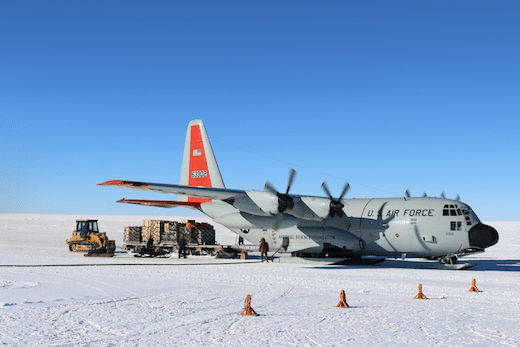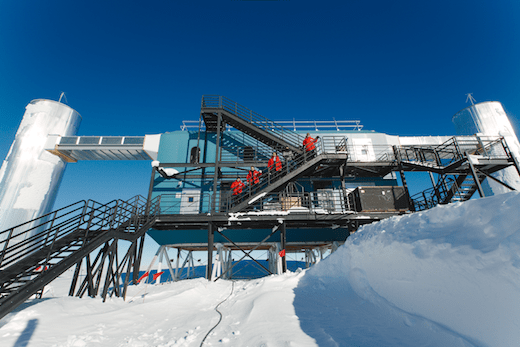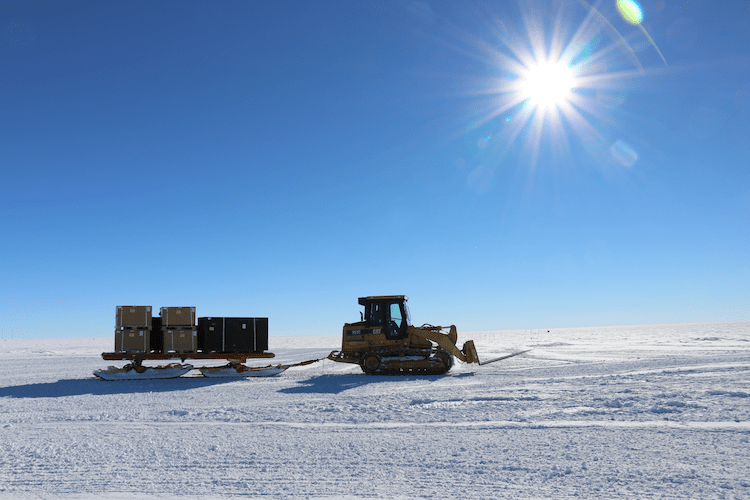Austral summers are not as exciting as they once were for IceCube. There are no more strings to be deployed, and the detector is performing impressively. But still, getting as much data as possible from this huge telescope buried in the Antarctic ice depends on how much can be done at the South Pole during a few months with daylight and reasonable temperatures.
An LC-130 Hercules, equipped with skies, can only land and depart safely from the Pole when the temperature is above -40 F. And everyone and almost everything will get to the Pole on a “Herc,” as the insiders call it.

This austral summer, on November 4, Ian Rees was the first IceCuber to reach the Amundsen-Scott station, after a long trip from Boulder, Colorado. He was on the second Herc mission of the season. There he met Blaise Kuo Tiong and Felipe Pedreros, the 2012–13 IceCube winterovers, who have been taking care of the detector for the last 12 months. From now until the end of the IceCube polar season, 20 people will fly to the Pole from Madison, Maryland and Delaware in the US, but also from Canada, Germany, Sweden, and Belgium.
To do what, you may ask, since the detector is frozen in the ice and it looks like there is not much else to be done down there? These scientists will be on site to meet four crates of computers and other equipment shipped to Antarctica — all in all, almost 12,000 pounds of cargo.
“Besides our optical modules in the ice, IceCube also consists of almost 150 computers in the IceCube Lab, which are used for data acquisition, filtering, transfer, and storage. This season will see the largest detector upgrade since construction was completed. We’re upgrading all of the data readout computers and servers, in addition to our usual calibration activities,” says John Kelley, who manages the maintenance and operation of the IceCube detector.

A new polar season means, in fact, a full year at the Pole for the two new IceCube winterovers. Dag Larsen and Ian Rees will be replacing Blaise and Felipe. They join the growing group of adventurers, lovers of ice and physics, that keep the IceCube detector running even in the most extreme environment.
“IceCube is successfully taking data more than 99% of the time, and this high uptime depends upon maintenance of our systems during the austral summer and the hard work of the winterovers during the whole year. In the event of a problem, the winterovers are automatically paged, allowing them to quickly respond to the issue and keep the detector running,” explains Kelley.
Getting everyone and everything down to the Pole involves plenty of hours and people up in the north. A team of people in Madison and from other places around the IceCube Collaboration, working in close collaboration with the Antarctic Support Contractor (ASC) and NSF, has to assess every need and every pound of cargo. Moving people and equipment to Antarctica is expensive, but forgetting even the smallest detail can jeopardize a full season.
“The planning for each polar season actually begins with the submission of the Support Information Package (SIP) to ASC/NSF at the end of March each year. At that early time, we already have to have a firm handle on the cargo, people and tasks to be done at Pole the upcoming season,” explains Jim Haugen, who is responsible for the IceCube South Pole planning and logistics. Meetings take place every month between IceCubers and ASC to fine-tune the season. “We don’t want to have any surprises while the season is underway,” adds Haugen.
This season is a special one for IceCube. The government shutdown in October endangered the whole season. For a few days, the faces of hundreds of people in Madison and in Munich—where the full IceCube Collaboration was meeting to share discussions and excitement about new science results—showed concern for the future of IceCube, while the planned upgrades and operations were on hold. Besides, IceCube was never designed to remain off for a long time.

“The federal government shutdown in October certainly created a challenge for most of us working on the logistics of the current polar season. However, as it stands right now, the season is in good shape with our people arriving on time and the cargo only slightly delayed,” tells Haugen finally at ease.
“The polar season, which had already begun in McMurdo, came literally to a screeching halt and a number of projects based in McMurdo were canceled for the year. The South Pole season has a later schedule, perhaps that helped. Thanks to the dedication of people at the NSF and the support in the collaboration, we were able to establish that IceCube really has no parking position, and that it could cause damage to the equipment—not to mention the agonizing idea that a supernova might go off in such a moment. It is my understanding that funding is available for the entire season, which means if the issue comes up again in January, IceCube and polar operations should not be thrown into a crisis again,” explains Albrecht Karle, the IceCube Associate Director for Science and Instrumentation.
In the end, another austral summer has begun for IceCube. Get ready for new stories from the Pole!